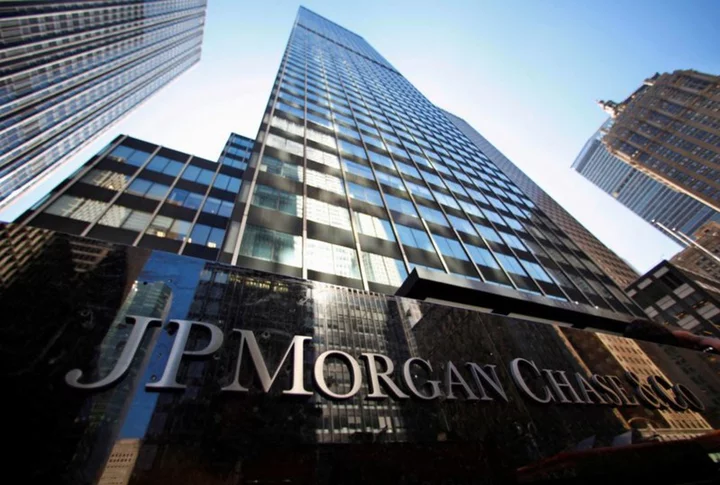By Tatiana Bautzer, Saeed Azhar and Niket Nishant
NEW YORK Profits at the biggest U.S. consumer lenders are likely to rise in the third quarter, in contrast with investment banks still facing a dealmaking slump, analysts said.
JPMorgan Chase, which kicks off earnings for big U.S. lenders Friday, will set the tone for large banks. It is predicted to post a roughly 25% jump in earnings per share (EPS) versus a year earlier, LSEG estimates showed.
Goldman Sachs and Citigroup are expected to report the biggest EPS declines of 35% and 26% respectively, according to LSEG estimates. Morgan Stanley's EPS is also forecast to drop.
"This quarter is all about higher interest rates for longer," said Mike Mayo, an analyst at Wells Fargo. "They will affect banks' funding, lending, ability of borrowers to repay loans, losses in securities and capital requirements."
JPMorgan, the nation's largest lender, is "best positioned" to handle higher rates and could surprise markets with stronger-than expected results, said Bank of America analyst Ebrahim Poonawala, who raised his earnings estimate.
U.S. employers added 336,000 positions in September in a return to the fevered hiring seen during the pandemic, potentially bolstering the case for another interest rate increase by the Federal Reserve. Another hike, and the persistence of elevated borrowing costs, could pour cold water on a nascent recovery in dealmaking.
Wall Street CEOs have cited the return of some initial public offerings, including for SoftBank's Arm Holdings, as signs of a market revival after months in the doldrums. The outbreak of war in Israel could further dampen market sentiment.
"There is a constructive environment, and investment banking fees tend to be higher through the end of the year," said Jason Goldberg, a banking analyst at Barclays. A broader improvement for capital markets may not come until 2024, he said.
Despite the renewed optimism, investment banking activity remains depressed. Global investment banking fees are down almost 17% in the third quarter from the same period a year earlier, to $15.2 billion, according to data from Dealogic.
Markets could be further shaken by surging U.S. Treasury yields, knocking investor confidence and posing some risks to banks that hold a large volumes of the securities on their books.
As rates rise, bond prices fall, representing losses on paper that would be realized if the banks sold the bonds. After Silicon Valley Bank collapsed in March partly because of losses from its securities portfolio, investors have focused on the risks posed by paper losses on bond holdings across the industry.
Unrealized losses from securities will show a "significant increase" to as much as $670 billion across the industry in the third quarter, estimated Richard Ramsden, a banking analyst at Goldman Sachs. That compares with $558 billion in the second quarter, according to data from the Federal Deposit Insurance Corporation.
For instance, Bank of America had more than $100 billion of unrealized losses on its securities portfolio that it aims to own until maturity, which have weighed on its shares. Its stock is the worst performer among the top six U.S. lenders, falling 21% so far this year.
Earnings from regional lenders will also remain in focus after a trio of bank failures earlier this year roiled the industry.
"Investors should be very careful with the regional banks, which have more ties to the fragile commercial real estate loan market and some regional banks have weaker balance sheets, which is concerning," wrote James Demmert, chief investment officer of Main Street Research, which manages about $2 billion in assets.
Large banks' consumer divisions are expected to remain a bright spot in their earnings. The strong job market has propped up household spending, although the pace of purchases has slowed, bank executives have noted in recent weeks.
Consumer delinquencies on loan payments have also picked up, but remain at low levels historically.
"It's still credit normalization, as opposed to a real concern about credit losses getting to recessionary type levels," Ramsden said. More broadly, "we're back into this environment where investors think interest rates are going to remain higher for longer," he said.
EPS ESTIMATES FOR THIRD QUARTER
Bank 3Q23 3Q22 % change
Estimate*
Citi 1.20 1.63 -26%
JPMorgan 3.91 3.12 +25%
Bank of America 0.82 0.81 +1%
Morgan Stanley 1.33 1.47 -9.5%
Goldman Sachs 5.35 8.25 -35%
Wells Fargo 1.24 0.85 +46%
* Median estimate. Source: LSEG
(Reporting by Tatiana Bautzer and Saeed Azhar in New York and Niket Nishant in Bengaluru; Editing by Lananh Nguyen and Nick Zieminski)

